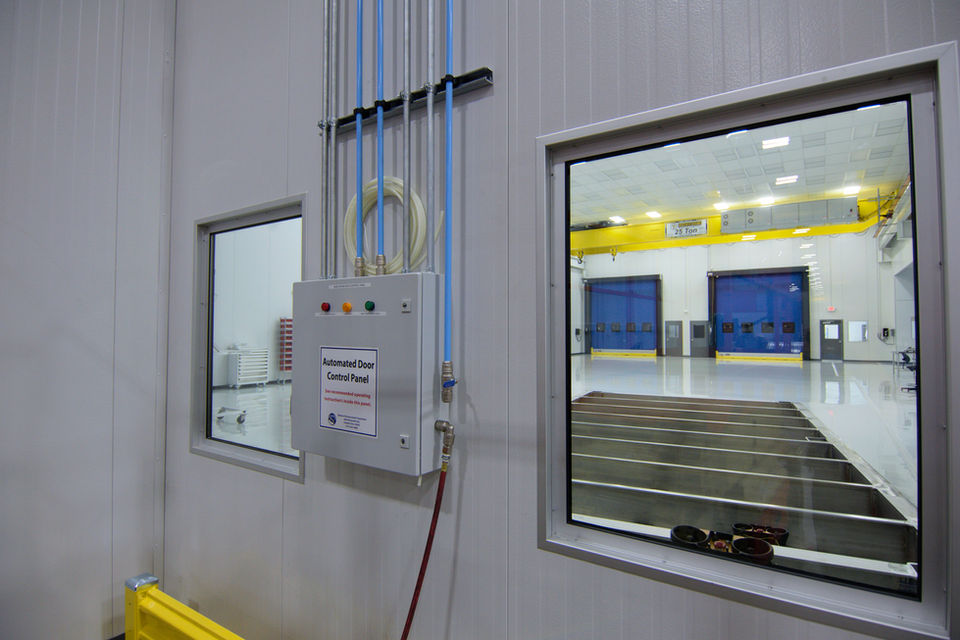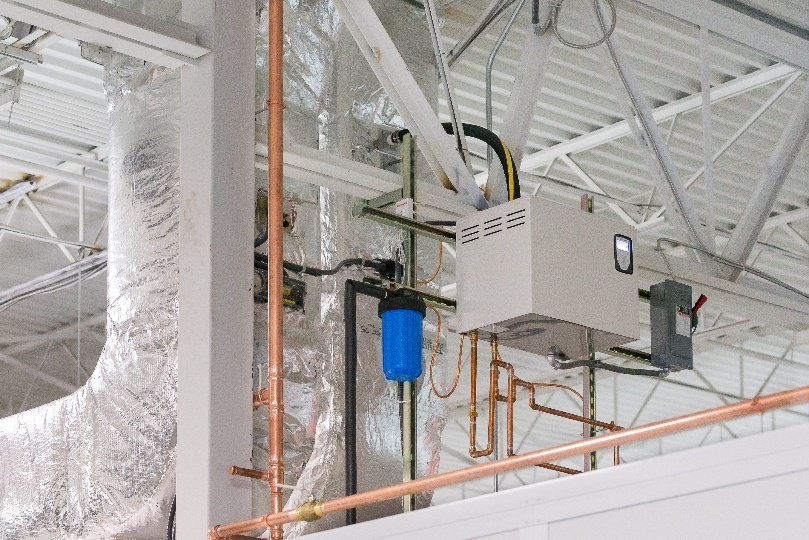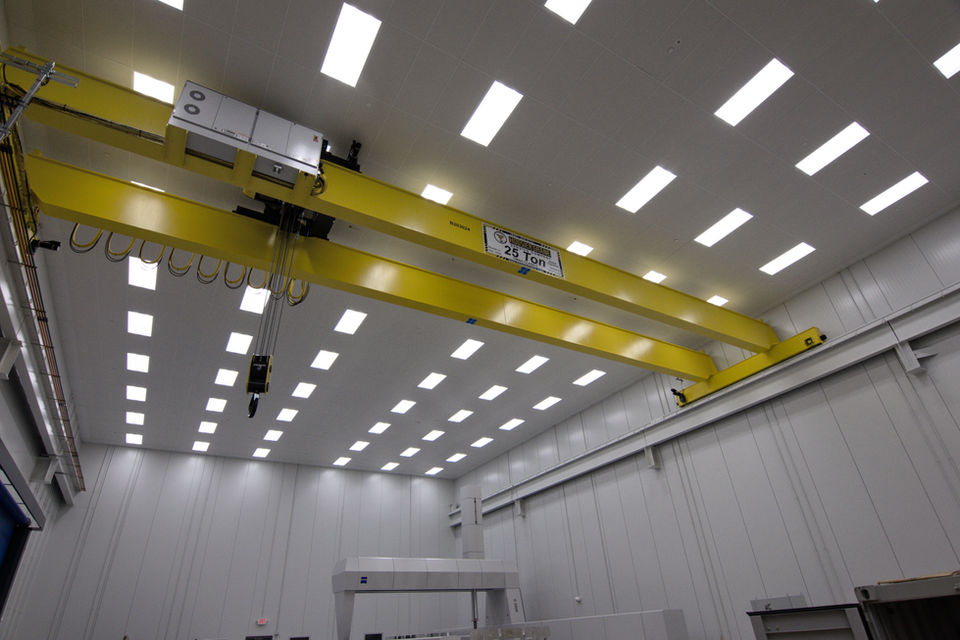
Benefits of Our
Design Build Approach
Why should you choose a design build firm for your next project?
This is an ideal option for project planners, business owners, facilities, and quality control personnel looking to build a controlled environment laboratory or clean room for several reasons. The greatest benefit is that you are working with just one team throughout the entire design and build process. This limits change orders, confusion of scopes, scheduling conflicts, and having to work with several firms at once. Communication is of the utmost importance with any construction project, at Western Environmental, communication with our clients is a number one priority. Throughout the duration of a project, we schedule several meetings, so all parties are always on the same page. Comparing this to the historical approach, which would include an architect designing a project, a general contractor winning the bid, and then sourcing several companies to construct the room. What happens when a room fails testing of particle counts, air changes, temperature, or humidity parameters? Here at Western Environmental, we specialize in controlled environments construction and alleviate the stress of receiving a poorly functioning clean room or laboratory, as we guarantee execution and performance as specified.
Our Customer Service and Support Offering:
-
Sales engineers that can travel to any location to meet with a customer and walk through a potential job site
-
Engineers experienced in all MEP’s
-
Onsite project managers who travel to our jobsites and oversee installation from start to finish
-
Estimators with 30+ years of industry experience
-
In house staff for preventative maintenance, testing and certification
What determines the cost of a controlled environment room such as a cleanroom?
Several factors need to be considered when designing a new controlled environment project.
For starters, the type of room:
-
Whether a Softwall or a Modular Cleanroom
-
The process taking place in the space, such as precision fabrication, critical measuring, life sciences, educational, packaging, hazardous, research, etc. The process is equally as important to know upfront
-
Location of the build and complexity of site access
-
Sizing of the room or rooms, and if structural steel is needed
-
HVAC specifications - the larger the cubic footage the bigger the system(s), and the tighter the specifications the more complex the design
-
How many HVAC systems should be used, multiple systems can offer some or full redundancy, which may be a critical requirement along with redundant control systems.
-
As well as HVAC equipment location, such as a facility roof or mezzanine, an exterior concrete pad, or inside the facility near the room, or on the new room’s roof
-
Adders such as flooring, pass thru’s, central vacuum systems, workstations, air showers, gowning rooms, automatic sliding doors, specialty doors, overhead doors, removable walls, walkable decks, staircases/ladders to access decks, cranes, fire suppression, etc. Just a few of these may add a decent percentage to the overall cost of a project.
Exploring Different Types of Clean rooms & controlled environment rooms
-
Softwall Cleanrooms – Cleanrooms with steel or aluminum frames, vinyl curtain walls, typically include HEPA or ULPA filtration. Offering ISO 8 to ISO 5 classifications and are affordable on any budget. If a grid ceiling can be suspended from your existing building support system, the need for a frame can go away. This is a great option for temporary storage that needs to remain a clean space. Softwall cleanrooms are an excellent source for meeting ISO classifications that do not need to maintain temperature and humidity control, such as in a room already environmentally controlled.
-
Softwall Cleanroom Options –Antistatic or ESD vinyl wall curtains, Additional finish color vinyl curtains, casters for portability, additional strip curtain entries, fan filter unit controllers, Sensitive or photolithography lighting, magnahelic gages, particle counters, removable ceiling sections for crane access, sliding or hinged roof access panels, conveyor cutouts, interior curtain walls.
-
Modular cleanrooms – Built with prefabricated building materials and are more durable than softwall cleanrooms. When designed correctly, modular clean rooms offer an excellent thermal envelope for precision temperature and humidity control. Modular cleanrooms offer the same benefit as a traditional cleanroom but require less labor and are typically more affordable to install, as well as can be reconfigured and expanded as needed.
-
White Room – Similar to a modular clean room but have looser mechanical specifications and the ISO classification is usually positive pressure only. Enough filtration to keep large particles out of a space but not classify as an actual cleanroom.
-
Machine Enclosure – Similar construction to a modular clean room or white room, a machine enclosure may just be walls and a ceiling. Or the machine may require temperature and humidity control to function properly, we can design the enclosure and HVAC system for your needs.

Designing a new controlled environment or cleanroom can be complex but our team of experts simplifies the process for you.
Primary Clean Room Designs - There are many different designs we can implement such as:
-
Direct ducted
-
Fan filter units (FFU’s)
-
Terminal units
-
Pressurized plenum
-
Negative pressure plenum
-
Multiple HVAC and control systems offering redundancy
-
Laminar air flow
-
Horizontal air flow
-
Or any combination of the above
Your process, location, budget, and building space available, will dictate which design route makes the most sense for your project. Below is a brief overview of just some of the materials, options, and methods we consider when designing a new clean room project:
Clean Room Wall Types – Galvanized steel insulated panels, stainless-steel, PVC, painted aluminum, fiberglass, FRP, glass, acrylic, vinyl curtains, vinyl faced panels, fire rated panels, structural panels, seamless construction, washable panels, powder coated, aluminum skin, aluminum honeycomb, laminate faced, cold welded, even studs and drywall can be used for a new cleanroom.
Clean Room Ceiling Systems – 1-1/2” or 2” powder coated or anodized aluminum grid systems, or any other specialty type grid can be incorporated. Perforated ceiling panels of either aluminum, stainless-steel, or powder coated steel. In lieu of grid ceiling systems, we may design with ceiling panels for critical room processes and seamless requirements.
Clean Room HEPA & ULPA Filtration – We work with several vendors for fan filter units, terminal HEPA & ULPA ceiling diffusers, HEPA or ULPA filter racks, and inline HEPA filtration. We will design your filtration needs to achieve the best efficiency, value, and standards as required.
Fan Filter Units – Whether we are drawing ambient air, direct duct, or these are included in a plenum design, we have several partner vendors for suppling every option on the fan filter unit (FFU) market. These include aluminum, powder coated steel, or stainless-steel construction bodies and face grilles, HEPA loading indicator lights, aerosol injection and sampling ports, A/C motors with either variable speed or 3-speed control, or D/C ECM “smart” type motors that will self-compensate for maintaining a desired CFM setpoint.
Fan Filter Unit Controllers - Wall mounted controllers can also be installed for ease of adjusting fan filter units at one control point. An added benefit with a controller is the units can be monitored by any building management system (BMS) or (DDC). The greatest benefit is the ability to have the fans run slower during non-production hours, saving on energy consumption. Designing energy efficient systems is very important to us.
Cleanroom Lighting – LED lighting is an ideal solution for cleanroom applications, whether we need flush mounted 1x1, 1x2, 2x2, 2x4 LED fixtures, teardrop fixtures, hazardous rated LED’s, flush grid, photolithography, research environment specialty lighting, shadow lighting, flow thru light troffers, UV lighting, or any additional. When higher foot candles (FC) are required, we will design the lighting layout and quantity required to achieve the requested lighting level.
Clean Room Flooring – There are cleanroom applications that require a new flooring be installed, we can design a raised perforated type for the ISO 4 class, or seamless flooring for the life sciences, anti-static for the electronics fields, epoxy painted for the higher ISO classes, welded vinyl, or vinyl composite tile (VCT) for the higher end finished look. There are of course controlled environment projects where your existing floor can be utilized just fine as well.
Cleanroom HVAC / Clean Room Mechanical – Your process may dictate the need for temperature and humidity control, and we are experts in the field of controlling both! We’re capable of building cleanrooms with temperatures maintained to ± 0.03° Fahrenheit to 0.06° Fahrenheit and relative humidity controlled to ± 2% of the set point. We will design your system as energy efficient as possible and guarantee the operating parameters as specified. We are cleanroom mechanical experts and welcome the challenging designs other cleanroom companies pass on.
Clean Room HVAC / Mechanical Control Systems – We build custom mechanical control systems in house, and we include them when we design a clean room or lab with a new HVAC system, these typically monitor and display in real time the following:
-
Cleanroom temperature
-
Cleanroom humidity
-
Cleanroom pressure
-
Fan status
-
Smoke detector
-
Cooling coil temperature
-
Supply air temperature
-
Overall average temperature
-
Overall average humidity
-
System alarms
Clean Room Particle Counters – When the need to monitor your particle count in real time is requested, we can include particle counters with pumps and a separate control system to display what the current particle counts are in your space. These offer time stamping as well so you can record as needed. These systems can also be relayed to your building management system (BMS) and monitored remotely.
Clean Room Entry Doors – Hollow metal doors and frames, PVC entry doors, FRP doors, sliding doors, automatic sliding doors, store-front, and many more types can be used in a new cleanroom. As long as the materials used in building the door work well with the process taking place, are not a weak spot for the thermal envelope, and make sense for the build, we can include them.
Clean Room Overhead Doors - When designing a new environmental room, we need to consider material entry after the room is built. Overhead doors rated for clean room use are a great solution for it. These can be simple inexpensive types or rapid roll ups capable of several feet per second.
Clean Room Air showers – In certain applications, an air shower makes sense. We work with some of the best vendors in the industry and receive favorable pricing incorporating these in a build. The options associated with an air shower are endless, and depend on the number of people using at one time, construction materials, layout configurations, filtration requirements, indicator lights.
Clean Room Pass thru cabinets – Depending on your requirements, these can be included with heavy duty laminate, powder coated steel, or stainless-steel construction. The standard build includes mechanical interlocking doors. These can be custom built however with electronic interlocking and HEPA filtration.
Clean room permit process – If your project requires pulling a permit, we can pull one for you or work under someone else’s. We can submit our drawings for permit approval and our installation is up to, or exceeding code requirements. Our onsite personal is OSHA certified and we are licensed to work all over the nation.
Clean Room Fire Suppression - Whether we need to add sprinklers and tie into your existing fire suppression lines, or we need to design a cleanroom dry chemical system for your project, adding fire suppression is just one more area included with our turnkey abilities.
Clean Room Air Drops – Often there are times we are requested to add airlines in our cleanroom builds, an extension of the host building’s system and used for cleaning, or customer equipment.
Cleanroom Stairs, Ladders & Handrailing for Decks – We design clean rooms and labs with walkable and load bearing decks often. One design feature we include is OSHA approved ladders or stairs with OSHA approved handrails for safety. Guard rails around the perimeter of cleanroom decking are included as well. Whether we are using the deck for mechanical equipment or if this will be used for light storage, we will design the space to fit your needs.
Clean Room Cranes – If your turnkey project requires us to integrate an existing cleanroom crane or include a new one, we have several partner firms who will assist in engineering the best solution for your requirements.
The Importance of Energy Efficient Controlled Environments
When we design your cleanroom, enclosure, or laboratory, we will look at all aspects of the build to make sure the system is as energy efficient as possible. This usually involves using the best thermal envelope materials as we can, as well as designing the most efficient HVAC systems. Recirculating the highest percentage of conditioned air we can to ensure lower energy consumption. The combination of design, material selection, and proper installation are all key aspects to the performance of a build.

Cleanroom Testing
Testing your clean room is key to accomplish contamination-free manufacturing and research. Western Environmental recommends routine clean room testing to maintain efficient operation as well as monetary savings.
Our Primary Clean Room Testing Services
Non-viable particle counting - The process of measuring the particulate matter in the air to assure that the enclosure meets or exceeds the desired ISO classification as described in ISO 14644:2015.
Airflow Test – Performed to measure the supply airflow into both unidirectional and non-unidirectional clean rooms or clean zones. Calculating the supply air flow volume and air change rates (air changes per hour)
Air pressure differential test – Verifies the capability of the clean room HVAC system to maintain the specified pressure differential between clean rooms and its surrounding area. This test is done after acceptance of the airflow test.
Temperature test – Verifies the air temperature within the clean room to conform with the HVAC control system set points. This can be spot checked or tested over a specified period.
Humidity test - Verifies the moisture within the clean room to conform with the hvac control system set points. This is measured in relative humidity or dew point. Depending on the client's needs this can be a onetime reading or many readings over a period.
HEPA Filter Testing – Performed to make sure the high efficiency air filter is properly installed and free of defects. (Leaks - tiny holes in the filter medium or damages to the frame, seal, and framework) Ensures HEPA filters in clean room provide the filtration needed to maintain specified ISO classification.
Optional Clean Room Testing services
Airflow directional test and visualization – Uses a source of visible fog to determine the airflow direction and its sameness of velocity meet the design and performance of the clean room. Air flow pattern visualization test can be done at-rest and repeated in operational state to simulate actual operation.
Room recovery test – Performed to determine if a clean room or clean zone can return to a specified cleanliness level after being exposed briefly to an airborne particulate challenge.
Air Balancing – Adjust airflow in the clean room HVAC control system to achieve design airflow, air exchange rates, and differential pressure.
Lighting, vibration, sound – Performed to check clean room design specifications as well as ensure occupant’s comfort.
Containment leak test – Makes sure no intrusion of unfiltered air is coming into the clean room. (Doorways, joints, seams, and pressurized ceilings)
Particle deposition test – Verifies the quantity and particles released from the air in the clean room onto a surface over a specific period.
Other optional clean room testing
Segregation test, electrostatic and ion generator tests, viable environmental monitoring, compressed air, and gas testing
Western Environmental does additional testing requested by client
Begin Your Project
From clean room design to CMM enclosure expansion, Western Environmental is your source for ISO 17025 accredited controlled environment services. Get a quote online, or call us at 513-422-4088 for more information on how we can help.













